What Is a Scope of Work?
A scope of work document is an agreement on the work you’re going to perform on the project. The scope of work in project management includes deliverables, a timeline, milestones and reports. Let’s look closer at each of these elements below.
What Should Be Included in a Scope of Work Document?
Below is an overview of the main components of a scope of work. You can add or remove some of these elements to better adjust to your project stakeholders’ requirements.

Get your free
Scope Of Work Template
Use this free Scope Of Work Template for Word to manage your projects better.
Project Deliverables
This is what your project delivers. Whether it’s a product or a service, it’s the reason you’re executing the project for your customer, stakeholder or sponsor. Whatever that deliverable is, and it can be some sort of document or report, software, product, build (or all of the above), you need to clearly identify each item here. Creating a work breakdown structure can help with this step. Also, make sure there’s an acceptance criterion for the project deliverables, such as quality standards or functional requirements.
Project Timeline
Think of a timeline as a road leading from the start of a project to its end. It’s a section of the document that delineates the major phases across the schedule of the project’s duration. It should also mark the points in the project when your deliverables are ready. As you can guess, it’s essential to scope out the overall plan of any project. This is best presented visually, like a rolled-up Gantt chart plan, so the stakeholders can see the high-level timeline.
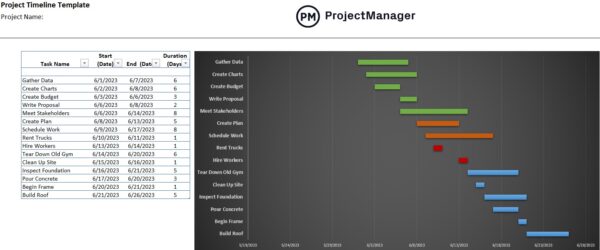
Project Milestones
Projects can be long and complex, which is why they’re laid out over a timeline and broken down into more manageable parts called tasks. Larger phases of the project are marked by what’s called a milestone. It’s a way to help you monitor the progress of the project to ensure it’s adhering to your planned schedule. Define your key milestones on a timeline in the scope of work document, including project kickoffs, meetings, hand-offs, etc.
Project Reports
You’ll be generating reports throughout the project, delivered to either your team or customer, stakeholder or sponsor. These can include status reports, progress reports, variance reports and more. They’re a formal record of the progress of your project, but they’re also a means of communication beyond whether the project’s on schedule or not.
Depending on how you customize reports, there’s a wealth of data that can serve a number of different audiences. Define how you’ll be reporting on the project and when the stakeholders can be expecting them and from whom.
Scope of Work Template
Now that you know what’s included in this all important document, download our free scope of work template for Word. It has everything you need to make a scope of work document for your own project, so your stakeholders know exactly what to expect in terms of schedule, deliverables and effort.
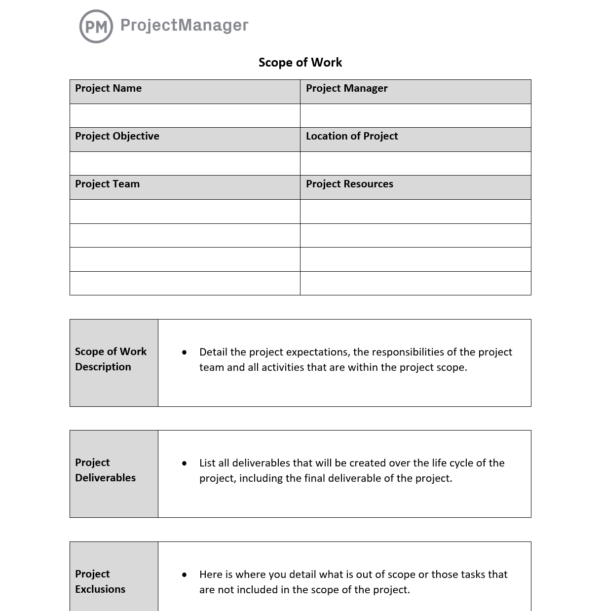
How to Write a Scope of Work
Now that we’ve listed the elements of a scope of work document, let’s go through the step-by-step process of writing one. These steps can help you create a scope of work for different industries such as construction or manufacturing.
- Define the project goals: Before writing a scope of work, you should define what project goals will be accomplished through the execution of the project tasks that’ll be included in your scope of work.
- Use a work breakdown structure to identify project tasks: The first step when writing a scope of work is to identify all your project tasks. This is done by using a work breakdown structure (WBS), a project management tool that lets you break down projects and work packages into individual tasks, so you can better plan and schedule them.
- Determine your project deliverables: A project deliverable is a tangible or intangible output from tasks. They’re an important part of a scope of work as they’re the outcomes of the project.
- Establish acceptance criteria for your project deliverables: Project deliverables must meet the acceptance criteria established by the project client, such as quality standards or functionality requirements.
- Use the CPM method to create a project timeline: The critical path method is a project scheduling technique that allows project managers to create a project timeline and estimate project duration by identifying the longest sequence of tasks. It’s important that you use this or other project scheduling techniques to create a realistic schedule for your scope of work.
- Establish payment terms for the project: You may include payment terms as a section of your scope of work.
- Establish project reporting procedures: Communication between the project team and project stakeholders is very important, so your scope of work document should include a section that explains how reporting will take place.
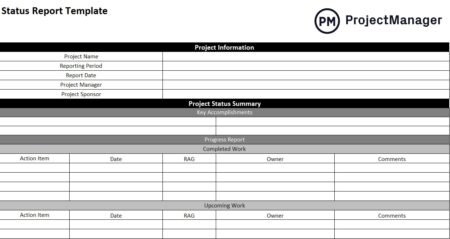
Scope of Work Example
To understand the purpose and importance of a scope of work in project management, let’s start with a simple scope of work example, planning a wedding. A wedding is a project, and depending on the bridezilla (or groomzilla), it could be bigger and more complicated than building a highway or an airport.
Let’s take one aspect of that larger project, the wedding invitations, and break this down into a scope of work. We’ll outline the deliverables, timeline, milestones and reports in this scope of work example.
Deliverables
- Invite list
- Addresses of attendees
- Invites
- Addressed envelopes
- Stamps
Timeline
- Jan. 1: Decide on the invite list
- Feb. 1: Have addresses collected of attendees
- March 1: Pick invitation style and have printed
- April 1: Address and mail invites
- May 1: Get the final count of guests
- June 1: Wedding
Milestones
- Selection of guests and collection of addresses
- Mailing of invitations
- The final count of attendees
Reports
- Check on the status of address collection
- Stay in touch with the printer for progress on invitations
- Check RSVPs against the invitation list
With ProjectManager, you can build a project timeline in seconds with our online Gantt chart maker. Map your scope of work, create a budget, assign tasks, add dependencies and more. Then present to your team and stakeholders to get the project moving on the right foot. Try it free today.

Construction Scope of Work Example
Now, let’s create a scope of work for a small construction project, building a house. This project involves many steps, but for practical purposes, this construction scope of work example will only focus on some of the main deliverables, timelines, milestones and reports.
Project deliverables: These project deliverables are individual, tangible outputs from different construction activities.
- Land clearing
- Ground leveling
- Footings
- Foundation
- Sewer Lines
- Wood Framing
- Sheathing Installation
- HVAC system installation
- Electrical panels and wiring installation
- Roof installation
- Insulation installation
- Drywall installation
- Interior painting, appliances, cabinets and other final details
Project Timeline: The scope of work timeline depends on the complexity of the construction design and the agreement that the project owner reaches with the general contractor, who will hire subcontractors to accomplish different types of construction work.
Project Milestones: The scope of work milestones marks important achievements during the project as tasks are executed. Instead of referring to individual project deliverables, they describe project phases that have been completed successfully. As a project manager, you might choose the milestones that are significant for your project.
- The building envelope has been completed
- Foundation, framing, plumbing and electrical inspections have been passed
- Exterior work has been completed
- Interior work has been completed
- Project has been delivered successfully
Project Reports: The reports that you use to track the scope of work might vary, but these are essential construction project reports.
- Project status reports
- Daily construction logs
- Construction punch list
Why Is It Important to Write a Scope of Work?
Here are some of the reasons why writing a scope of work is beneficial for projects.
Defines the Project Scope
The main purpose of a scope of work is to define the scope of a project. This means defining the work that’ll be done as well as project exclusions, activities or deliverables which aren’t part of a project.
Prevents Scope Creep
Scope creep is a risk that can affect any project. It occurs when additional project tasks are added to the initial project scope during the execution of a project.
These unplanned additions of tasks to the work plan cause extra costs and derail the project schedule. Scope creep can be avoided by having a clear scope of work that establishes what will and what won’t be executed. However, changes might be made to the project scope by using a change request, another important project management document.
Sets Clear Expectations for Project Stakeholders
Without a scope of work document, project stakeholders might have unrealistic expectations about a project, such as assuming certain tasks and deliverables will be done. Therefore, it’s important for project managers and project teams to make sure there’s a scope of work that lets stakeholders know what to expect.
For example, a scope of work is an important element of a project proposal, which is one of the project management documents that allow project management teams to explain stakeholders such as clients or project sponsors what they can expect from a project.
Related: Project Proposal Template
Scope of Work Tips
But before you get to writing, you need to make sure you follow these tips.
- Be specific: explain the terms used clearly
- Use visuals: a picture is worth a thousand words
- Get sign-offs: make sure everyone who needs to okay the work, does
It’s not that difficult, but it needs to be thorough because you don’t want to have to play catch-up with paperwork when you’re in the heat of the project.
Pro tip: The SOW is essential to the project plan and is often included as part of the overall project plan, but it can be time-consuming to write. We’ve created dozens of project management templates to help you create all your project documents.
How to Manage Your Scope of Work With Project Management Software
It can feel overwhelming with so many tasks to keep track of, but project management software can simplify the process. In ProjectManager, you can import your spreadsheet or use one of our industry-specific templates to get you started.
A list of tasks is only a start. To bring order to that chaos, you’ll want to estimate duration by adding start and finish dates. We then automatically put your tasks on a timeline in our Gantt chart project view, so you can see the whole project in one place. Further reign in the tasks by prioritizing them, linking dependencies to prevent bottlenecks later in the project and setting milestones to break up the larger project into more manageable phases.
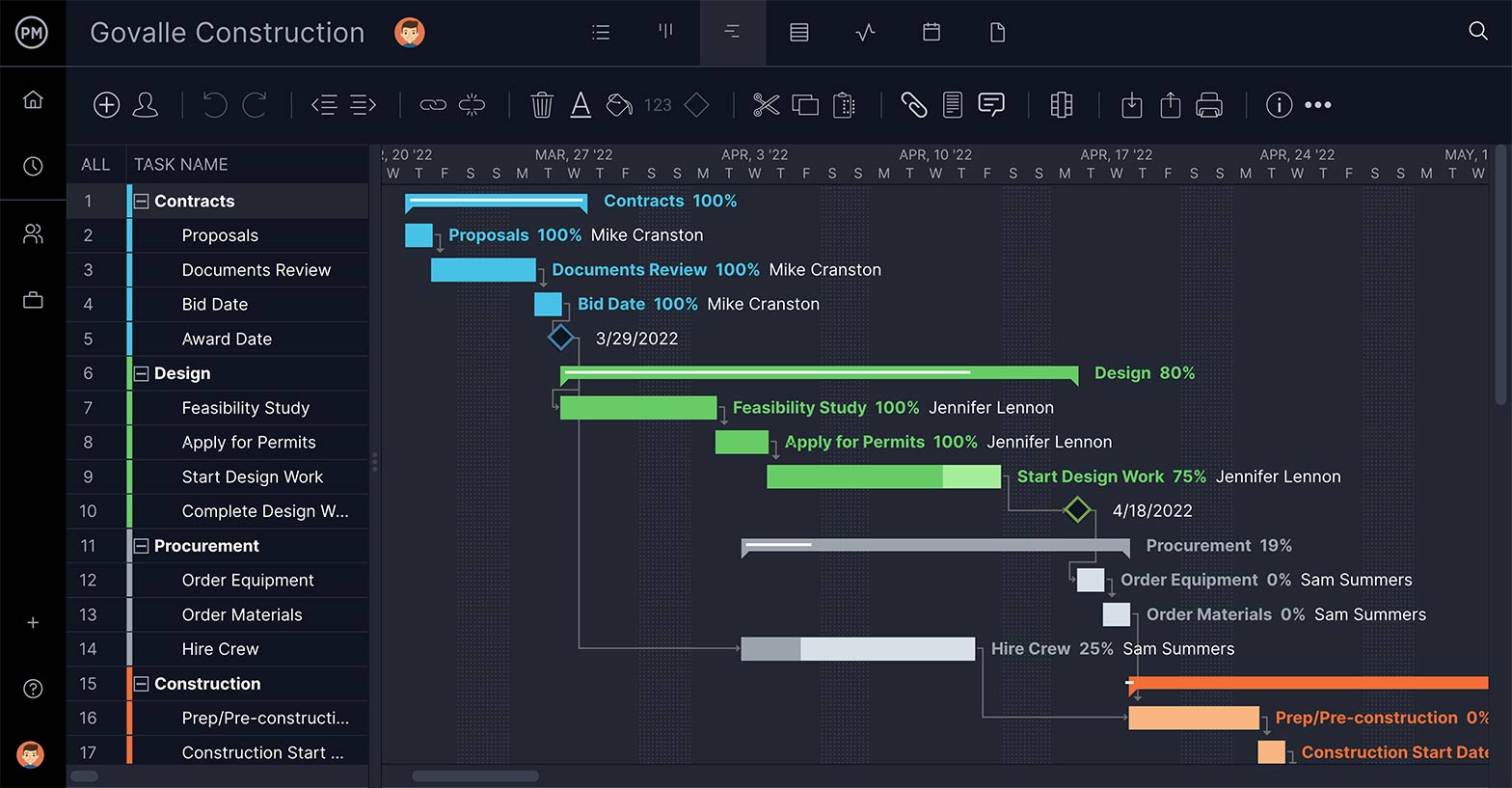
Collaborate at the Task Level
Tasks need people to execute them and move your project forward. You have your schedule, so onboard your team and start assigning them tasks. You can do this from any of our multiple project views. We offer collaborative tools that make teams more productive and help them work together. You can direct them with task descriptions and by attaching files to the task. Then, they can work together, commenting at the task level with other team members, who are notified by email. This is great for remote teams and even those working in the same room.

Track Progress to Stay On Time and Under Budget
Speaking of distributed teams, how can you keep track of their progress if you can’t check in on them? We solve that problem with great monitoring features, such as a real-time dashboard that shows you task progress, costs and other high-level views of the project. Our software takes status updates and automatically displays them in easy-to-read charts and graphs. You can even share them at stakeholder meetings to keep them in the loop.
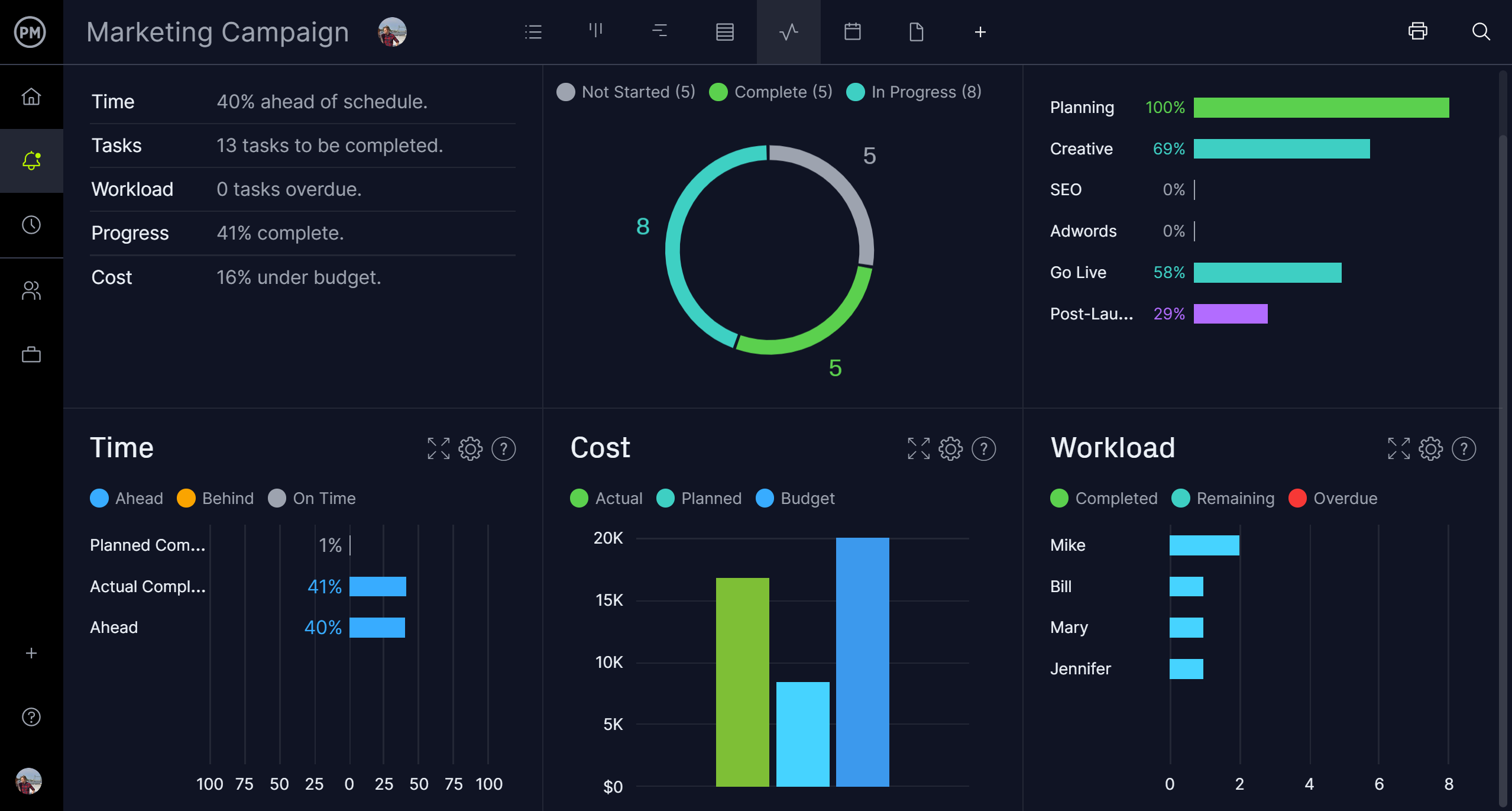
For more in-depth data, we feature one-click reports that can be filtered to show just the data you’re looking for. Reports track project variance, workload and more. You’ll catch issues and resolve them quickly before they become problems that threaten to derail your project.
If you want that scope of work to be the beginning of a beautiful project, then try ProjectManager for free with our 30-day trial offer.
Video: Scope of Work Best Practices
In this video, Jennifer Bridges, PMP, shows you how to write a scope of work for project management. Follow her steps to get started or use our project plan and scope document template!
Here’s a shot of the whiteboard for your reference!
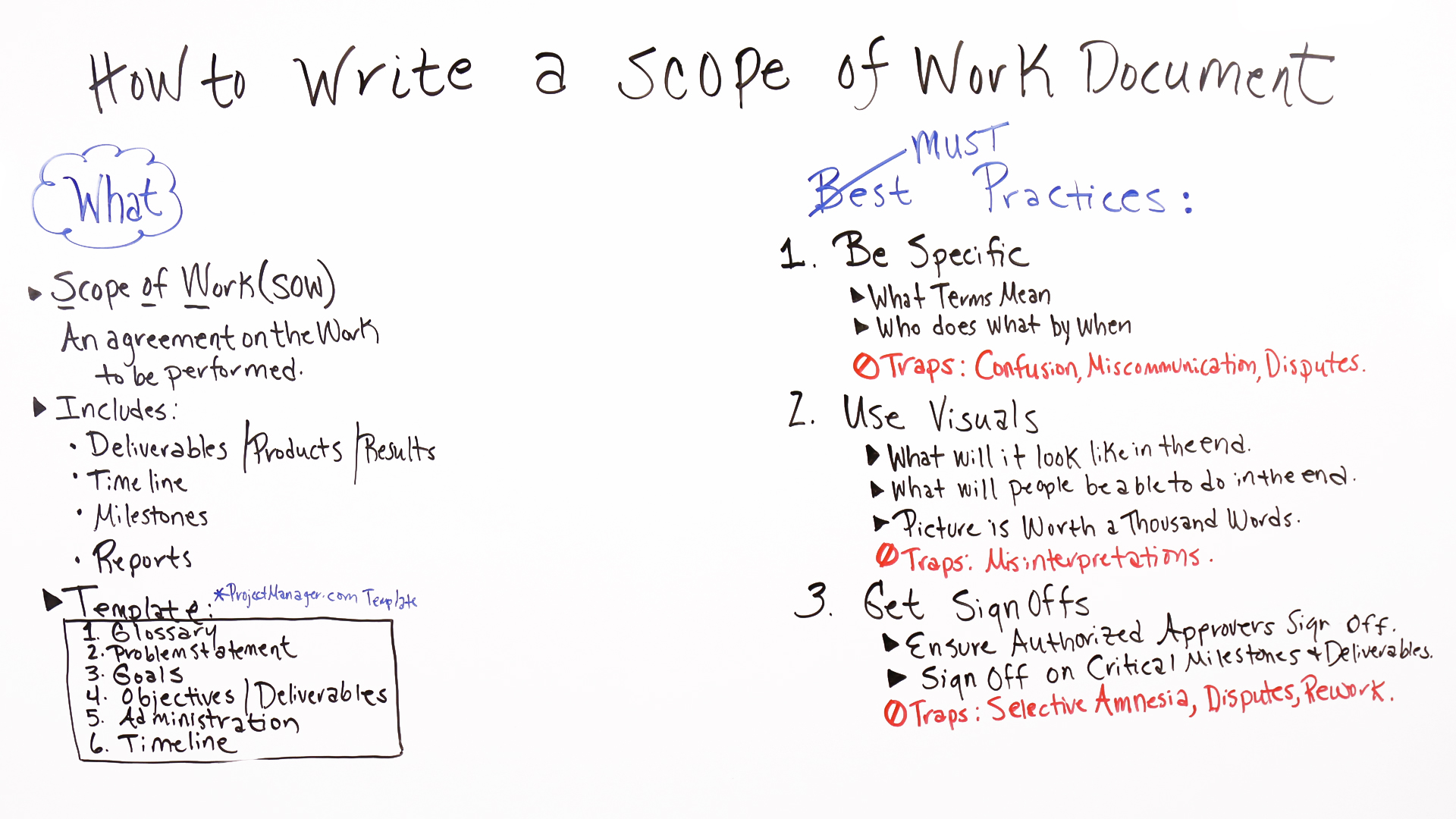
Related Project Planning Content
- Project Documentation: 15 Essential Project Documents
- How to Create a Project Execution Plan (PEP)
- How to Write a Scope of Work
- How to Write an Action Plan (Example Included)
If you need a tool that can help you manage and track your scope of work document, then sign up for our software now at ProjectManager.


